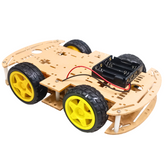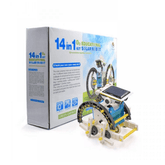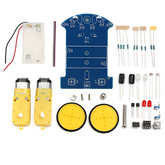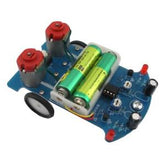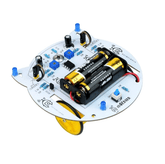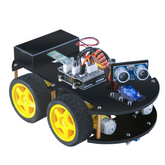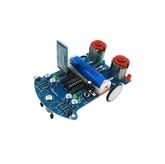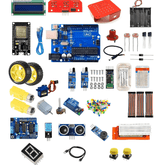A to Z of Robotics
Summary
Dive into the fascinating world of robotics with our comprehensive blog, 'A to Z of Robotics.' Explore the origins of robotics, from its invention to the present day. Discover the who, what, and when behind this revolutionary field. Uncover the secrets of learning robotics and its importance in today's technology-driven era. Delve into the exciting realm of robotics for kids and the intertwined world of automation and artificial intelligence. Learn about the diverse types of robotics, the role of sensors, and where this cutting-edge technology is applied. Embark on a journey through the captivating 'A to Z of Robotics' and unlock the future possibilities it holds!
Introduction
Robotics is an interdisciplinary branch of engineering and science that deals with the design, construction, operation, and application of robots. It integrates fields including mechanical engineering, electrical engineering, computer science, and mathematics to enable the design and creation of robotic systems that can perform automated, complex, and repetitive tasks efficiently and with precision. From its origins in early mythical automata and mechanical toys, robotics has grown to become an essential technology woven into many aspects of modern life and industry.
What is Robotics?

Robotics involves conceiving, designing, building, programming, and applying robots. Robots are programmable machines capable of carrying out complex series of actions automatically by means of electronic and mechanical components. These actions are programmed and controlled by a computer system inside or connected externally to the robot. The field of robotics brings together knowledge from subject areas like mathematics, algorithms, control systems, artificial intelligence, material sciences, structural analysis, manufacturing and more to enable the creation of functional robots.
The key components that make up a robot include:
- Mechanical parts and structural components like frames, motors, wheels, grippers that provide structure, movement capabilities and the ability to manipulate objects.
- Sensors that collect data about the environment like cameras, proximity sensors, pressure sensors, encoders etc. This data is used to perceive the surroundings.
- Controllers including microcontrollers and computers that process sensor data and issue appropriate commands.
- Actuators that execute commands by moving the mechanical components. Common actuators include motors, pneumatic actuators, and hydraulics.
- Programming that provides intelligence and decision making capabilities to carry out tasks. This can include artificial intelligence and machine learning algorithms.
Robotics integrates these components into capable autonomous systems that can perform activities for industrial, domestic, commercial, military or other applications. From handling hazardous materials, assembling products, and exploring extraterrestrial planets to everyday housework robots are enabling automation across many human domains.
Who Invented Robotics?
The origins of early robotics and automata date back millennia, with examples like mechanical toys, automated machines and artificial beings described in ancient myths, folklore and fiction. The development of more sophisticated early precursors to modern robotics emerged across different cultures and eras:
- Ancient Greek engineers like Ctesibius and Philo of Byzantium built elaborate programmable mechanical devices and water clocks with moving figures.
- Inventors in ancient China created intricate automated puppets, carts and humanoid automatons powered by waterwheel and gear systems.
- Arabic polymath Al-Jazari described designs for programmable humanoid automata, mechanical musical instruments and other ingenious machines in his 1206 book.
- Renaissance era engineers and inventors like Leonardo da Vinci sketched plans for humanoid machines and other automatons.
The foundation for modern robotics technology was gradually built up over centuries across the world through basic mechanisms, gear systems, clockwork devices and fundamental mechanical engineering.
Some key names that contributed to early development of robotics include:
- George Devol - Developed first digitally operated and programmable robotic arm called Unimate in the 1950s, leading to rise of industrial robotics.
- Joseph F. Engelberger - Engineer who helped commercialize early industrial robotics in the U.S by founding the world's first robotics company Unimation with George Devol.
- Isaac Asimov - Famous science fiction author who coined the term "robotics" and devised the influential Three Laws of Robotics.
When Was Robotics Invented?

While basic automated machines have existed for thousands of years, contemporary robotics as a unified field traces its origins back to the 20th century:
- 1898 - Nicola Tesla demonstrates first radio-controlled vessels, laying groundwork for remote control robotics.
- 1921 - Czech writer Karel Capek introduces the term "robot" in his play R.U.R., which features artificial people created to serve humans.
- 1942 - Isaac Asimov formulates the Three Laws of Robotics in his short story Runaround influencing future robotics development.
- 1954 - George Devol files patent for the first digitally operated programmable robot arm.
- 1961 - First industrial robot Unimate is installed at a General Motors plant, heralding era of industrial robotics.
- 1966 - Shakey the robot built by SRI International becomes first general purpose mobile robot making use of vision, navigation and problem solving.
- 1969 - Stanford Research Institute develops Shakey capable of logical reasoning for navigating and planning.
- 1970s - Programmable robot arms become widely adopted for automating mass production in factories.
- 1997 - NASA's Pathfinder mission deploys first wheeled robotic Mars rover Sojourner, proving viability of autonomous robots in space exploration.
- 2002 - iRobot introduces Roomba, the first commercially successful consumer home robot product.
- Present day - Robotics continues to accelerate with expanding applications of AI, machine learning, computer vision, sensors and actuators.
How to Learn Robotics

Some of the core knowledge areas and skills useful for building competency in robotics include:
- Mechanical engineering - mechanisms, kinematics, actuators, structural design
- Electrical engineering - circuits, motors, sensors, microcontrollers, wiring
- Computer programming - proficiency in languages like C, C++, Python to code robot control systems
- Mathematics - fundamentals like algebra, trigonometry, calculus for mechanics and control algorithms
- Algorithm design - for navigation, planning, decision making and control logic
- Artificial intelligence - machine learning techniques like neural networks for enabling intelligent behavior.
Useful resources for learning and applying robotics skills include:
- University courses in robotics engineering, control systems, mechatronics etc. Many offer open courseware content online.
- Books like Robotics: Modelling, Planning and Control by Bruno Siciliano et al for theory and fundamentals.
- Open source robotics platforms - ROS is a widely used open software framework for robotic projects.
- DIY robotics kits from providers like Lego Mindstorms, MakeBlock, VEX Robotics and Arduino kits.
- Online robotics simulations and 3D modelling software like V-REP, Gazebo, MATLAB can supplement hands-on learning.
- Robotics competitions like FIRST Robotics, RoboCup and robotics hackathons offer practical challenges.
- Joining robotics communities, makerspaces and taking up projects assists practical learning.
Robotics requires multidisciplinary skills but hands-on building of real robotic systems accelerates learning. Using a combination of theory, programming and practical projects with affordable kits is an effective way to get started.
What is Robotics for Kids?
Robotics can be a fun, engaging way to introduce children to STEM (Science, Technology, Engineering and Math) concepts. Some benefits and ways robotics is used in kids education include:
- Introduces principles of engineering design, electronics, and computer programming through a hands-on, DIY approach.
- Builds logical thinking, spatial skills, problem solving and mathematical abilities.
- Working in groups on projects teaches teamwork, communication and collaboration skills.
- Sparks interest in STEM fields and careers. Surveys show students find robotics enjoyable and enriching.
- Range of interactive robotics kits available designed for different age groups and skill levels.
What is Automation and Robotics?

Automation refers to using technology to complete tasks automatically without ongoing direct human control. It minimizes the need for human work and intervention in processes. Automation makes use of programmable machines, computers and control systems to handle activities ranging from small-scale mechanisms to enterprise-wide operations.
Some examples of automation include:
- Conveyor belts streamlining assembly line production in factories
- Automated airport baggage handling systems transporting luggage
- Self-checkout kiosks replacing cashiers at retail stores
- Logistics robots delivering packages in warehouses
- Home automation adjusting smart thermostats, lighting, appliances
Robotics and automation are closely linked - many automated systems make use of robotics technology to enable and enhance automation. Characteristics where robotics supports automation include:
- Robots can reliably perform repetitive tasks consistently without tiring or rest.
- Complex sequential actions can be fully automated beyond human capabilities.
- Robots can function reliably in hazardous environments unsuitable for people.
- Multiple synchronized robots can dramatically scale up automation.
- Robot flexibility allows adapting the automation to new scenarios.
Automation driven by robotics increases speed, efficiency, scale and capability across many domains from manufacturing to surgery. Continued improvements in robotic capabilities will expand the scope of automation across our economies and societies.
What is AI Robotics?
AI or artificial intelligence refers to simulating human-level intelligence and cognition in computer systems. AI includes diverse technologies like machine learning, neural networks, computer vision and natural language processing to enable systems that can think and act intelligently like humans.
AI robotics involves incorporating AI capabilities into robotic systems to make them more autonomous, flexible and capable at complex tasks. Key ways AI strengthens robotics include:
- Computer vision - To understand environments from visual data enabling navigation, object recognition etc.
- Natural language processing - For natural communication and understanding of spoken commands.
- Machine learning - To improve robot control policies and skills from experience and data.
- Motion planning - Finding optimal robot motions and manipulation strategies using search algorithms.
- Knowledge representation - Encoding facts about objects, actions and goals for reasoning and problem solving.
AI transforms robots from predefined automatons into adaptive, intelligent assistants. Service robots like housecleaning robots rely extensively on AI techniques for functionality like mapping, object recognition, grasping, and interactive communication skills. AI robotics will continue to enable more capable autonomous systems.
Types of Robotics
Some major categories of robots include:
- Industrial Robots - Automatically handle manufacturing tasks like assembly, welding, packaging, material handling and more in factories and warehouses. Common types include robotic arms, mobile robots, collaborative robots working alongside humans.
- Service Robots - Perform useful tasks like professional or personal services for humans. e.g. vacuuming, lawn-mowing, elderly assistance, surgery robots, delivery robots etc.
- Defense and Security Robots - Used for military and security applications like surveillance, defusing bombs, guard patrols, rescue missions. UAVs or drones are widely adopted remotely operated robots.
- Medical Robots - Assist doctors and surgeons, automate lab work and deliver medications in healthcare settings. e.g. surgical robots, exoskeletons, robot prosthetics, disinfectant robots.
- Space Robots - Specialized robots built to survive harsh space environments and conditions while exploring celestial bodies in our solar system. e.g Mars rovers like Curiosity, robotic arms aboard the ISS.
- Entertainment and Hobby Robots - Designed for recreation, pleasure and fun. e.g. robot dog companions, humanoid home robots, fighting robots.
Continuing advances across these application areas are expanding the capabilities and benefits of robotic systems in diverse facets of human activity.
What is Robotics Technology?
The field of robotics integrates knowledge across mechanical, electrical, computing, design and control systems engineering. Some key technologies that enable robots include:
- Actuators - Generate movement and force to manipulate objects. e.g. servo motors, pneumatic actuators, hydraulic cylinders.
- Sensors - Measure robot state and environment properties like distance, temperature, acceleration etc. e.g. LiDAR, infrared, encoders, GPS.
- Controllers - Microcontrollers and computers process data and control robot components.
- Artificial Intelligence - Enables intelligent decision making, learning and problem solving capabilities.
- Computer Vision - Cameras and image processing identify objects, guide navigation and manipulation.
- Materials - Lightweight composites, alloys, plastics create strong, rigid and flexible structures.
- Power Systems - Batteries, electric generators, supercapacitors providing required electrical energy supply.
- Communications - Wireless networking enables connectivity with robot controllers and the cloud.
- Simulation - Software emulating robots in virtual environments used for prototyping.
- Manufacturing - Advanced fabrication techniques like 3D printing assist rapid prototyping.
Innovations across these diverse supporting technologies continually push forward robot capabilities across metrics like speed, precision, endurance, intelligence and miniaturization.
Why is Robotics Important?
Some of the importance and benefits driving increased adoption of robotics include:
- Productivity - Robots improve efficiency, reduce costs and downtime for industries like manufacturing, logistics and agriculture.
- Safety - Robots can prevent human exposure to dangerous environments like extreme temperatures, radioactive contamination etc.
- Precision - Robotic accuracy and repeatability exceeds human capabilities for tasks like surgery and nano-scale electronics assembly.
- Space Exploration - Robots enable exploring inhospitable extraterrestrial environments like distant planets and moons.
- Assisted Living - Robots assist elderly and disabled with mobility, caregiving, monitoring and rehabilitation therapy.
- Discovery - Underwater drones explore deep oceans. Robots speed up processes like drug discovery through automated lab work.
- Defense - Robots used in warfare, border patrols, bomb disposal protect human lives. UAVs conduct reconnaissance and surveillance.
- Entertainment - From video games to robot pets, robots provide fun, engaging experiences through interactivity.
Accelerating advances in robotics will allow automating new aspects of business, society, manufacturing, surgery and our personal lives. The future growth possibilities remain expansive.
What are Sensors in Robotics?
Sensors are devices that detect and measure physical properties like temperature, pressure, motion, distance, position etc and convert them into electrical signals that robotic systems can interpret and process. Robots use multiple different sensors to achieve perception of their environment. Some key categories of sensors used in robotics include:
- Proprioceptive sensors - Measure internal states of robot like motor speed, joint angles, wheel motion. e.g. motor encoders, inertial measurement units.
- Exteroceptive sensors - Measure external environment of robot e.g ultrasonic, infrared and LiDAR sensors for proximity detection.
- Vision sensors - Cameras and image processing provide visual perception of surroundings.
- Tactile sensors - Measure touch, pressure for manipulating objects and physical interactions.
- Temperature sensors - Measure ambient or object temperatures. Useful for activities like soldering.
- Force sensors - Measure contact forces during manipulation for precision control.
- Acoustic sensors -Enable audio input and voice commands using microphones.
- Position sensors - GPS provides global position data for outdoor navigation.
Sensor data provides the raw inputs enabling the robot to perceive and interact with its environment. Combining multiple sensor types creates rich robotic perception for accomplishing tasks.
Where is Robotics Used?

Some of the major industries and applications where robotic systems are utilized include:
- Manufacturing - Robots automate production, improve quality control and optimize assembly operations in factories e.g. welding, painting, pick and place, palletizing.
- Warehouses - Automated robots and robotic arms streamline logistics for order fulfillment and inventory management tasks.
- Healthcare - Surgical robots assist doctors, automated delivery robots transport medications in hospitals. Exoskeletons aid rehabilitation.
- Defense - Drones, bomb disposal robots, sentry robots and unmanned sea/ground vehicles take on dangerous military missions.
- Agriculture - Robots automate tasks like pruning, weeding, spraying, harvesting to improve farming productivity.
- Space - Advanced robots explore distant planets and moons, conduct experiments and orbital construction in space.
- Mining/Construction - Robots improve safety and efficiency in hazardous environments like mines, confined spaces.
- Services - Robotic vacuum cleaners, gutter cleaners, lawn mowers perform domestic and commercial services.
- Logistics - Mobile warehouse robots automate goods transportation, sorting and storage to optimize supply chains.
Increasing adoption across industries reflects the expanding benefits and capabilities robots provide in diverse commercial, industrial and domestic settings.
Conclusion
Robotics has progressed remarkably from early mechanical automata to becoming an advanced technological field powering highly capable semi-autonomous and intelligent machines. Continued improvements in sensing, manipulation, intelligence and design expand the horizons of robotic systems across industries, scientific exploration and our everyday lives.
Upcoming developments in areas like artificial intelligence, machine learning, computer vision, new materials and power sources will accelerate robotic capabilities. As costs continue to decline, robotics promises to become ubiquitous across business and society. Tremendous potential remains for robotics to transform areas ranging from automated cars, caregiving robots in aging societies to robotic space colonization. International competition is driving robotics innovation in countries like China, USA, Japan and Germany. The 21st century is likely to be defined by an age of intelligent machines working alongside humans to improve productivity, discovery and progress.
Frequently Asked Questions
1. Who is the father of robotics?
The father of robotics is widely considered to be George Devol, an American inventor and entrepreneur. He created the first industrial robot in 1954 called Unimate, which was used to automate tasks on assembly lines for General Motors. This groundbreaking invention revolutionized manufacturing processes and paved the way for future advancements in robotics technology. Devol's contributions did not stop there; he also patented several other robotic inventions such as mechanical hands and programmable machinery. His vision of robots performing repetitive tasks with precision has greatly influenced industries worldwide, ranging from automotive production to healthcare.
2. What is manipulator in robotics?
A manipulator in robotics is a fundamental component that enables robots to interact with their environment. It refers to the mechanical arm or tool attached to a robot's body, which mimics the human hand and wrist movements. This advanced mechanism allows precise positioning and manipulation of objects, making it an essential element for various applications such as assembly line operations, material handling tasks, and medical procedures.
3. How to become a robotics engineer after 12th?
If you have a passion for technology and are intrigued by the world of automation, then becoming a robotics engineer in India may be the ideal career path for you. To embark on this journey after completing 12th grade, certain steps must be taken to pave your way towards success. The first step is obtaining an undergraduate degree in engineering or computer science with a focus on Robotics from a reputable institution. This will equip you with fundamental knowledge about robots and their design principles. Next, gain practical experience through internships or projects related to robotics industry. Additionally, joining professional organizations like The Institution of Engineers (India) and participating in workshops/seminars can keep you updated on advancements within the field.
4. What is mean by robotics?
Robotics encompasses a wide range of disciplines including engineering, computer science, and other scientific fields to create intelligent machines known as robots. These advanced creations can operate independently or with minimal human assistance to perform various tasks in multiple industries. Combining sensors, controllers, and actuators allows these robots to sense their surroundings and execute precise actions accordingly. Through automation technology has transformed sectors such as manufacturing, healthcare, agriculture, and transportation by streamlining processes, reducing expenses, and promoting safety. With continued developments in artificial intelligence and machine learning, the possibilities for how robots can shape our world are endless. Delegates who attend robotic workshops experience firsthand this revolutionary field that will continue advancing towards new frontiers of innovation. Get on board with robotics today ,to be part of the magnificent transformations that are shaping the future!
5. Which engineering is best for robotics?
When it comes to robotics in India, there are various engineering fields that play a crucial role. However, one can argue that electrical and electronics engineering stands out as the best option for those looking to venture into this rapidly growing field. With advancements in automation technology and artificial intelligence, expertise in these two areas has become increasingly valuable. Electrical engineers possess a thorough understanding of electronic systems and components which is essential for designing cutting-edge robots with complex circuitry. Moreover, their knowledge of power management provides an edge when developing energy-efficient robotic solutions – an important aspect given the country’s limited resources. Henceforth, pursuing electrical or electronics engineering would be most beneficial for those seeking a career path within the exciting realm of robotics in India.
6. What is robotics in simple words?
Robotics is a dynamic field of science and engineering that focuses on the creation, operation and utilization of robots. It incorporates concepts from diverse areas such as computer science, electrical engineering, mechanical engineering and mathematics to develop machines or devices that can autonomously perform tasks with precision and accuracy. The term 'robot' was initially coined by a Czech playwright in 1920; however it wasn't until the mid-20th century when robotics truly emerged as its own technical discipline. Today, advancements in technology have propelled robotics into new frontiers allowing for more sophisticated designs and capabilities. From manufacturing industries to healthcare settings, robotic systems are revolutionizing work processes globally through efficient automation.
7. How robotics gained a vital place in environment sector?
Robotics technology has fundamentally transformed the environmental sector in recent years. Its widespread adoption can be attributed to its unparalleled efficiency and precision when performing tasks that were previously done manually. This revolutionary technology is redefining waste management, water conservation, pollution control, and biodiversity monitoring within this industry. The integration of robots not only maximizes productivity but also mitigates human error that could have severe implications for the environment. Furthermore, with rapid advancements in artificial intelligence and machine learning capabilities, these intelligent machines are now capable of adapting and learning from their surroundings; making them even more effective at tackling pressing environmental issues head-on. As a result, robotics has emerged as an indispensable tool towards achieving a sustainable future for our planet.
8. What technology is used in robotics?
The world of robotics is heavily reliant on technology to bring these machines to life. From simple household robots to complex industrial ones, a variety of technologies are utilized for efficiency and functionality. A crucial component in this realm is artificial intelligence (AI), which enables robots to think independently through intricate algorithms. Along with AI, sensors like cameras, lasers, and sonars allow robots to perceive their surroundings and interact accordingly. Meanwhile, motors provide movement capabilities while microcontrollers act as control centers for various tasks performed by the robot's motors and sensors. As technology continues its rapid evolution, we can anticipate more advanced techniques being incorporated into the field of robotics in the future.
9. What are the main fields in robotics?
The main fields in robotics include industrial robotics, medical robotics, service robotics, military robotics, and research robotics. Each field focuses on specific applications and technologies, from manufacturing automation to surgical assistance. Advances in artificial intelligence and machine learning continuously expand these domains, enhancing robotic capabilities across various industries.
10. What are the five types of robots?
The five types of robots include industrial robots, service robots, medical robots, exploration robots, and consumer robots. Industrial robots are used in manufacturing, while service robots assist with tasks in various sectors. Medical robots perform surgeries, exploration robots venture into uncharted territories, and consumer robots include household appliances and personal assistants.
11. How does robotics impact industries?
Robotics significantly impacts industries by increasing efficiency, reducing labor costs, and improving safety. Automation streamlines production processes, while robots handle repetitive or hazardous tasks. This leads to higher productivity and allows human workers to focus on more complex jobs, fostering innovation and growth in sectors like manufacturing, healthcare, and logistics.
12. Which skills are needed for robotics?
Key skills needed for robotics include programming, mechanical engineering, electrical engineering, and system integration. Understanding artificial intelligence and machine learning principles is also essential. Problem-solving and critical thinking skills are crucial for troubleshooting and optimizing robotic systems. Collaboration and communication abilities are important when working in multidisciplinary teams.
13. What are common robotics applications?
Common robotics applications include manufacturing automation, warehouse logistics, surgical assistance, and explorations such as space and underwater missions. Robots are also used in agriculture for tasks like planting and harvesting, as well as in service industries for customer support and cleaning. These applications enhance precision, efficiency, and safety across various sectors.
1. Who is the father of robotics?
The father of robotics is widely considered to be George Devol, an American inventor and entrepreneur. He created the first industrial robot in 1954 called Unimate, which was used to automate tasks on assembly lines for General Motors. This groundbreaking invention revolutionized manufacturing processes and paved the way for future advancements in robotics technology. Devol's contributions did not stop there; he also patented several other robotic inventions such as mechanical hands and programmable machinery. His vision of robots performing repetitive tasks with precision has greatly influenced industries worldwide, ranging from automotive production to healthcare.
2. What is manipulator in robotics?
A manipulator in robotics is a fundamental component that enables robots to interact with their environment. It refers to the mechanical arm or tool attached to a robot's body, which mimics the human hand and wrist movements. This advanced mechanism allows precise positioning and manipulation of objects, making it an essential element for various applications such as assembly line operations, material handling tasks, and medical procedures.
3. How to become a robotics engineer after 12th?
If you have a passion for technology and are intrigued by the world of automation, then becoming a robotics engineer in India may be the ideal career path for you. To embark on this journey after completing 12th grade, certain steps must be taken to pave your way towards success. The first step is obtaining an undergraduate degree in engineering or computer science with a focus on Robotics from a reputable institution. This will equip you with fundamental knowledge about robots and their design principles. Next, gain practical experience through internships or projects related to robotics industry. Additionally, joining professional organizations like The Institution of Engineers (India) and participating in workshops/seminars can keep you updated on advancements within the field.
4. What is mean by robotics?
Robotics encompasses a wide range of disciplines including engineering, computer science, and other scientific fields to create intelligent machines known as robots. These advanced creations can operate independently or with minimal human assistance to perform various tasks in multiple industries. Combining sensors, controllers, and actuators allows these robots to sense their surroundings and execute precise actions accordingly. Through automation technology has transformed sectors such as manufacturing, healthcare, agriculture, and transportation by streamlining processes, reducing expenses, and promoting safety. With continued developments in artificial intelligence and machine learning, the possibilities for how robots can shape our world are endless. Delegates who attend robotic workshops experience firsthand this revolutionary field that will continue advancing towards new frontiers of innovation. Get on board with robotics today ,to be part of the magnificent transformations that are shaping the future!
5. Which engineering is best for robotics?
When it comes to robotics in India, there are various engineering fields that play a crucial role. However, one can argue that electrical and electronics engineering stands out as the best option for those looking to venture into this rapidly growing field. With advancements in automation technology and artificial intelligence, expertise in these two areas has become increasingly valuable. Electrical engineers possess a thorough understanding of electronic systems and components which is essential for designing cutting-edge robots with complex circuitry. Moreover, their knowledge of power management provides an edge when developing energy-efficient robotic solutions – an important aspect given the country’s limited resources. Henceforth, pursuing electrical or electronics engineering would be most beneficial for those seeking a career path within the exciting realm of robotics in India.
6. What is robotics in simple words?
Robotics is a dynamic field of science and engineering that focuses on the creation, operation and utilization of robots. It incorporates concepts from diverse areas such as computer science, electrical engineering, mechanical engineering and mathematics to develop machines or devices that can autonomously perform tasks with precision and accuracy. The term 'robot' was initially coined by a Czech playwright in 1920; however it wasn't until the mid-20th century when robotics truly emerged as its own technical discipline. Today, advancements in technology have propelled robotics into new frontiers allowing for more sophisticated designs and capabilities. From manufacturing industries to healthcare settings, robotic systems are revolutionizing work processes globally through efficient automation.
7. How robotics gained a vital place in environment sector?
Robotics technology has fundamentally transformed the environmental sector in recent years. Its widespread adoption can be attributed to its unparalleled efficiency and precision when performing tasks that were previously done manually. This revolutionary technology is redefining waste management, water conservation, pollution control, and biodiversity monitoring within this industry. The integration of robots not only maximizes productivity but also mitigates human error that could have severe implications for the environment. Furthermore, with rapid advancements in artificial intelligence and machine learning capabilities, these intelligent machines are now capable of adapting and learning from their surroundings; making them even more effective at tackling pressing environmental issues head-on. As a result, robotics has emerged as an indispensable tool towards achieving a sustainable future for our planet.
8. What technology is used in robotics?
The world of robotics is heavily reliant on technology to bring these machines to life. From simple household robots to complex industrial ones, a variety of technologies are utilized for efficiency and functionality. A crucial component in this realm is artificial intelligence (AI), which enables robots to think independently through intricate algorithms. Along with AI, sensors like cameras, lasers, and sonars allow robots to perceive their surroundings and interact accordingly. Meanwhile, motors provide movement capabilities while microcontrollers act as control centers for various tasks performed by the robot's motors and sensors. As technology continues its rapid evolution, we can anticipate more advanced techniques being incorporated into the field of robotics in the future.
9. What are the main fields in robotics?
The main fields in robotics include industrial robotics, medical robotics, service robotics, military robotics, and research robotics. Each field focuses on specific applications and technologies, from manufacturing automation to surgical assistance. Advances in artificial intelligence and machine learning continuously expand these domains, enhancing robotic capabilities across various industries.
10. What are the five types of robots?
The five types of robots include industrial robots, service robots, medical robots, exploration robots, and consumer robots. Industrial robots are used in manufacturing, while service robots assist with tasks in various sectors. Medical robots perform surgeries, exploration robots venture into uncharted territories, and consumer robots include household appliances and personal assistants.
11. How does robotics impact industries?
Robotics significantly impacts industries by increasing efficiency, reducing labor costs, and improving safety. Automation streamlines production processes, while robots handle repetitive or hazardous tasks. This leads to higher productivity and allows human workers to focus on more complex jobs, fostering innovation and growth in sectors like manufacturing, healthcare, and logistics.
12. Which skills are needed for robotics?
Key skills needed for robotics include programming, mechanical engineering, electrical engineering, and system integration. Understanding artificial intelligence and machine learning principles is also essential. Problem-solving and critical thinking skills are crucial for troubleshooting and optimizing robotic systems. Collaboration and communication abilities are important when working in multidisciplinary teams.
13. What are common robotics applications?
Common robotics applications include manufacturing automation, warehouse logistics, surgical assistance, and explorations such as space and underwater missions. Robots are also used in agriculture for tasks like planting and harvesting, as well as in service industries for customer support and cleaning. These applications enhance precision, efficiency, and safety across various sectors.



